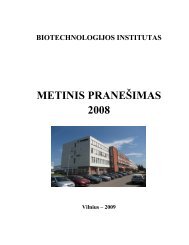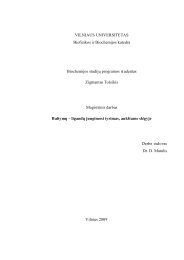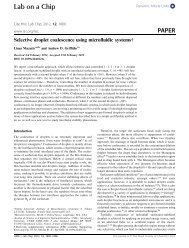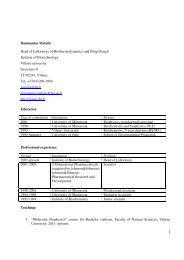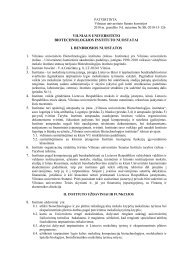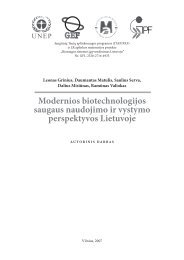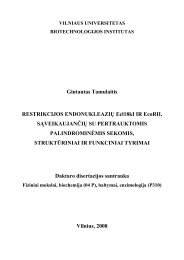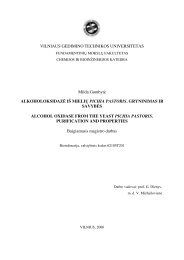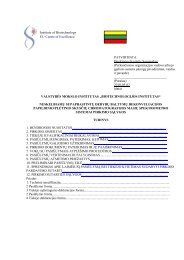Report 2008-2010
Report 2008-2010
Report 2008-2010
You also want an ePaper? Increase the reach of your titles
YUMPU automatically turns print PDFs into web optimized ePapers that Google loves.
Here at the LBDD we have cloned and purified most soluble CAs and<br />
truncated versions of CAs with removed transmembrane domains.<br />
Laboratory participated in the characterization of hCA IX (Hilvo et al,<br />
<strong>2008</strong>). The organic synthesis team together with collaborators designed<br />
and synthesized over 200 novel compounds that bind CAs with<br />
submicromolar affinity. Several novel groups of CA inhibitors exibited<br />
high affinity and appreciable selectivity towards selected CA isozymes<br />
(Dudutiene et al. 2007; Baranauskiene et al. <strong>2010</strong>; Sudzius et al. <strong>2010</strong>;<br />
Capkauskaite et al. <strong>2010</strong>).<br />
Inhibition of Hsp90 chaperone<br />
Heat shock protein 90 (Hsp90) is a molecular chaperone that is responsible<br />
for the correct folding of a large number of proteins. Client<br />
proteins of Hsp90 include many overexpressed oncogenes that are<br />
critical for the transformed phenotype observed in tumours.<br />
Our laboratory is interested in the mechanism of Hsp90 action and<br />
the thermodynamics of inhibitor binding. Thermodynamics of a natural<br />
compound radicicol binding to human Hsp90 alpha and beta<br />
isozymes and yeast Hsc82 was studied by isothermal titration<br />
calorimetry, thermal shift assay, and the pressure shift assay. These<br />
studies provided an unusual and detailed picture of Hsp90 inhibitor<br />
binding energetics. Radicicol bound Hsp90 with exceptionally large<br />
Figure 2. Radicicol binds Hsp90 with high affinity in the order of 100 pM K d . Titration calorimetry (graphs on the left) yield a stepwise curve – too steep to determine<br />
the Kd. Thermal shift assay (graphs on the right, upper panel – fluorescence dependence on temperature at various added ligand concentrations,<br />
lower panel – T m dependence on added ligand concentration) provides quite precise measurement of the binding constant.<br />
exothermic enthalpy and volume of binding (Zubriene et al 2009,<br />
Zubriene et al. <strong>2010</strong>, Toleikis et al, submitted).<br />
A novel group of inhibitors has been designed and synthesized based<br />
on similarity to radicicol and several inhibitors designed by Vernalis,<br />
UK. Our series of inhibitors were significantly easier to synthesize and<br />
possessed comparable activity towards HeLa and osteosarcoma cells<br />
(Cikotiene et al, 2009). Structure – thermodynamics analysis provided<br />
further insight into the mechanism of such inhibitor binding to Hsp90.<br />
35 th anniversary<br />
44



